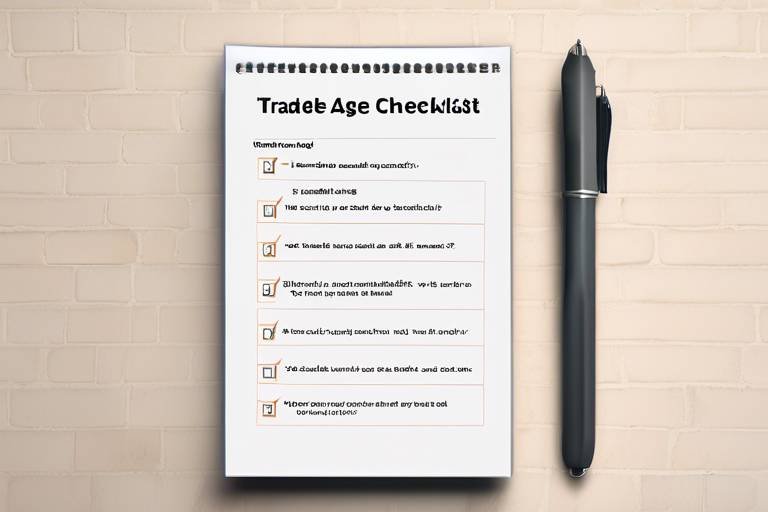Strategies for Using Multiple Time Frames
When it comes to trading, understanding the concept of multiple time frames can be a game changer. Imagine trying to navigate a vast ocean without a map; that’s what trading can feel like without a clear grasp of time frames. By analyzing various time frames, traders can gain a more comprehensive view of market movements, which ultimately leads to better decision-making. So, how do you effectively utilize multiple time frames in your trading strategy? Let’s dive into some proven strategies that can help you maximize your trading potential.
Time frames are essentially the intervals at which price data is analyzed. They can range from as short as one minute to as long as monthly charts. Each time frame offers a different perspective on market trends and price action. For instance, a 1-minute chart may show short-term volatility, while a daily chart captures longer-term trends. Understanding these differences is crucial because they can significantly affect your trading strategy. It’s like looking at a painting from different distances; each perspective reveals unique details that can alter your interpretation.
Utilizing multiple time frames in trading provides several advantages that can enhance your overall strategy. Here are some key benefits:
- Comprehensive Market View: By analyzing different time frames, you can see both the micro and macro trends in the market, allowing for well-informed trading decisions.
- Trend Confirmation: Multiple time frame analysis helps in confirming trends. If a trend is visible on a higher time frame and supported by a lower time frame, it adds credibility to your trading signal.
- Risk Management: Understanding the broader market context helps you manage risk more effectively. You can identify potential reversals and adjust your position sizes accordingly.
Trends can vary significantly when observed across different time frames. For example, a stock might be in a downtrend on a weekly chart but show bullish signals on a 15-minute chart. To effectively identify and confirm trends, it's essential to analyze various time frames simultaneously. Start with the higher time frames to gauge the overall market direction, and then drill down to lower time frames for entry and exit points. This layered approach is akin to peeling an onion—each layer reveals more depth and insight into your trading decisions.
Understanding the distinction between short-term and long-term trends is vital for traders. Short-term trends can be influenced by market news, earnings reports, or economic data releases, while long-term trends often reflect broader economic conditions and investor sentiment. Recognizing how these trends interact can greatly influence your trading decisions. For example, if you're trading based on short-term movements, but the long-term trend is bearish, you might want to exercise caution. It's like driving a car; you need to keep an eye on the road ahead while also checking your mirrors for immediate surroundings.
One of the most effective strategies is to combine time frames for trend confirmation. When a trade signal appears on a lower time frame, check if it aligns with the trend on a higher time frame. For instance, if you see a buy signal on a 4-hour chart, confirm that the daily chart also shows an upward trend. This dual confirmation can significantly enhance the accuracy of your trade signals and reduce the likelihood of false entries. Think of it as having a second opinion from a trusted friend; it often leads to more confident decision-making.
To develop a successful trading strategy that incorporates multiple time frames, follow these steps:
- Define your primary time frame: Choose a time frame that aligns with your trading style, whether it's day trading, swing trading, or long-term investing.
- Analyze higher time frames: Use higher time frames to identify the overall trend and market sentiment.
- Use lower time frames for entry: Look for specific entry and exit points on lower time frames that align with the higher time frame trend.
- Review and adjust: Regularly review your strategy and make adjustments based on market conditions and your trading performance.
Even seasoned traders can fall into pitfalls when analyzing time frames. One common mistake is overtrading on short time frames. Traders often get caught up in the fast-paced nature of day trading and make impulsive decisions without considering the bigger picture. Another mistake is ignoring higher time frame signals. Failing to integrate these signals can lead to poor trading outcomes. Always remember, trading is not just about making quick profits; it’s about making informed decisions.
Many traders fall into the trap of overtrading when focusing on short time frames. The adrenaline rush of quick trades can lead to emotional decision-making, resulting in losses. To manage this risk, set strict trading rules and stick to them. Consider using automated trading systems to help eliminate emotional biases from your decisions.
Failing to consider signals from higher time frames can lead to poor trading decisions. Always integrate higher time frame analysis into your trading strategy. If a higher time frame indicates a bearish trend, it’s wise to be cautious with any bullish signals you might see on lower time frames. Think of it as navigating a ship; you wouldn’t ignore the weather forecast just because the sun is shining right now.
Q: What is the best time frame for trading?
A: The best time frame depends on your trading style. Day traders may prefer shorter time frames like 1-minute or 5-minute charts, while swing traders might look at daily or weekly charts.
Q: How many time frames should I analyze?
A: It’s generally beneficial to analyze at least three time frames: a higher time frame for trend direction, a medium time frame for confirmation, and a lower time frame for entry and exit points.
Q: Can I use multiple time frames for all trading strategies?
A: Yes, multiple time frame analysis can be applied to various trading strategies, whether you’re day trading, swing trading, or investing long-term.

Understanding Time Frames
When diving into the world of trading, one of the first concepts you’ll stumble upon is the idea of time frames. You might wonder, "What’s the big deal about time frames?" Well, time frames are essentially the backbone of trading strategies. They define the duration for which trades are held and significantly affect how traders perceive market movements. Think of time frames as different lenses through which you can view the market; each lens offers a unique perspective and can help you make more informed decisions.
In trading, time frames can be categorized into several types, each serving a distinct purpose. Here’s a quick overview:
- Short-Term Time Frames: These typically range from one minute to a few hours. Traders using short-term frames often engage in day trading or scalping, aiming to capitalize on small price movements.
- Medium-Term Time Frames: These span from several hours to a few days. Swing traders usually operate within this range, looking to capture larger price swings.
- Long-Term Time Frames: Ranging from weeks to months, long-term traders or investors focus on broader market trends, often disregarding short-term fluctuations.
Understanding these time frames is crucial because each one tells a different story about the market. For instance, a stock may look like it’s on a downward trend on a 5-minute chart, while the daily chart might reveal a strong upward trend. This discrepancy can lead to confusion and poor trading decisions if not analyzed correctly. Therefore, recognizing how different time frames interact can provide a more comprehensive view of market dynamics.
Moreover, the significance of time frames extends beyond just categorizing trades. They also play a pivotal role in risk management, trade execution, and psychological factors. Traders must ask themselves questions like, "Am I prepared to hold this position for a few minutes, hours, or days?" This self-reflection can significantly influence their overall trading performance.
To sum it up, mastering the concept of time frames is akin to learning the rules of a game before you start playing. It sets the foundation for your trading strategy and can be the difference between success and failure. So, the next time you analyze a chart, take a moment to consider the time frame you’re looking at and what it reveals about the market.

Benefits of Multiple Time Frame Analysis
When it comes to trading, the are like a treasure map leading you to the gold. By examining the market from different angles, traders can uncover insights that might otherwise remain hidden. Imagine standing on a hill, looking at the landscape below. From one vantage point, you see the winding roads, but from another, you can spot the rivers and valleys that shape the terrain. This is precisely what multiple time frame analysis offers – a comprehensive view of the market landscape.
One of the primary advantages is that it allows traders to identify long-term trends while also capitalizing on short-term opportunities. For instance, a trader might notice that the daily chart shows a strong upward trend, but the hourly chart reveals a temporary pullback. By recognizing this dynamic, a trader can make informed decisions, like entering a position during the pullback to ride the wave of the long-term trend.
Moreover, using multiple time frames helps in confirming trading signals. When a trader identifies a potential entry point on a shorter time frame, they can check the higher time frames to see if the same signal aligns with the overall market direction. This confirmation can significantly reduce the risk of false signals, which can lead to costly mistakes. Think of it as having a second opinion from a trusted friend before making a big decision.
Additionally, multiple time frame analysis enhances risk management. By understanding how different time frames interact, traders can better gauge their risk exposure. For example, if a trader sees a bullish signal on a 15-minute chart but notices resistance on the daily chart, they might choose to adjust their stop-loss levels or position size accordingly. This proactive approach can safeguard their trading capital and improve overall performance.
Here's a quick overview of the key benefits:
- Comprehensive Market View: Gain insights from various time frames.
- Trend Identification: Spot both long-term and short-term trends.
- Signal Confirmation: Reduce the chances of false signals.
- Improved Risk Management: Better assess risk exposure and make informed decisions.
In conclusion, the benefits of multiple time frame analysis are undeniable. By incorporating this strategy into your trading routine, you can enhance your understanding of market movements, make better-informed decisions, and ultimately increase your chances of success. Just like a skilled navigator relies on multiple maps to find their way, traders can leverage multiple time frames to chart a successful course through the often turbulent waters of the financial markets.

Identifying Trends Across Time Frames
When it comes to trading, identifying trends across multiple time frames is like having a roadmap on a complex journey. Just as a traveler needs to know both the immediate route and the overall destination, traders must analyze short-term and long-term trends to navigate the market effectively. This approach allows traders to see the bigger picture while also honing in on the details that matter most. But how do we go about this?
First, it's essential to understand that trends can differ drastically depending on the time frame you’re examining. For instance, a stock might be experiencing a bullish trend on a daily chart, while simultaneously showing a bearish trend on a weekly chart. This divergence can create confusion, but it also presents opportunities. By analyzing these trends across various time frames, traders can identify potential entry and exit points that they might otherwise miss.
To identify trends effectively, one can utilize a combination of technical indicators and price action analysis. Indicators like moving averages, Relative Strength Index (RSI), and MACD can provide insights into the momentum of a trend. For example, if a 50-day moving average is trending upwards on a daily chart, and the price is above this average, it suggests a strong upward trend. However, if the same stock is below its 200-day moving average on a weekly chart, it may signal caution.
Here’s a simple breakdown of how to analyze trends across time frames:
- Start with the Higher Time Frame: Begin your analysis on a higher time frame, such as weekly or monthly charts, to understand the overall trend direction.
- Move to Intermediate Time Frames: Next, look at daily charts for a clearer picture of the trend's strength and potential reversals.
- Focus on Shorter Time Frames: Finally, drill down to hourly or minute charts to find precise entry and exit points.
By following this method, traders can confirm the direction of the trend and make informed decisions. For instance, if you notice that the higher time frame is bullish but the shorter time frames are showing signs of consolidation, it might be wise to wait for a breakout before entering a trade. This strategy not only enhances your chances of success but also helps in managing risk more effectively.
Moreover, it’s crucial to maintain a consistent approach when analyzing trends. Keeping a trading journal can help track your observations across different time frames. This way, you can identify patterns in your trading behavior and refine your strategy over time. Remember, trading is not just about making quick profits; it’s about developing a sustainable approach that can adapt to changing market conditions.
In summary, identifying trends across multiple time frames is a powerful strategy that can significantly enhance trading outcomes. By understanding the relationship between different time frames and utilizing various analytical tools, traders can navigate the complexities of the market with greater confidence. So, the next time you analyze a stock or currency pair, remember to take a step back and look at the full picture. Your trading strategy might just thank you for it.

Short-Term vs. Long-Term Trends
When it comes to trading, understanding the difference between short-term and long-term trends is akin to knowing when to sprint and when to pace yourself in a marathon. Short-term trends are typically identified on time frames ranging from minutes to a few hours. These trends can be influenced by immediate market sentiment, news releases, and other rapid developments. Traders who focus on short-term trends often seek quick profits, capitalizing on price fluctuations that occur within a single trading session.
On the other hand, long-term trends span days, weeks, or even months. They are shaped by more substantial economic factors, such as changes in monetary policy, economic indicators, and overall market cycles. Recognizing long-term trends is crucial for traders who aim to build wealth over time rather than chasing quick gains. By understanding the broader market context, traders can make more informed decisions that align with the underlying economic landscape.
To illustrate the differences between these two types of trends, consider the following table:
| Aspect | Short-Term Trends | Long-Term Trends |
|---|---|---|
| Time Frame | Minutes to Hours | Days to Months |
| Focus | Quick profits | Sustained growth |
| Influencing Factors | Market sentiment, news | Economic indicators, policies |
| Trading Style | Active trading, scalping | Position trading, investing |
Many traders make the mistake of exclusively focusing on short-term trends, often leading to a myopic view of the market. While short-term trends can provide thrilling opportunities, they can also result in significant volatility and emotional trading decisions. By contrast, long-term trends offer a more stable foundation for making informed trading choices.
So, how can traders effectively utilize both short-term and long-term trends? The key is to adopt a multi-time frame approach. This means analyzing both types of trends simultaneously to gain a comprehensive understanding of market movements. For instance, a trader may identify a strong long-term bullish trend but notice short-term bearish fluctuations. By recognizing these dynamics, they can adjust their strategies accordingly, perhaps entering trades on short-term dips while maintaining their long-term bullish outlook.
In summary, distinguishing between short-term and long-term trends is essential for any trader aiming to navigate the complexities of the market. By integrating insights from both perspectives, traders can enhance their decision-making process and ultimately improve their trading outcomes.

Combining Time Frames for Confirmation
When it comes to trading, the art of combining multiple time frames can feel like piecing together a complex puzzle. Each time frame offers a unique perspective on market movements, and when you analyze them together, you can create a clearer picture of the market's direction. Think of it as having multiple lenses through which you can view the same landscape. By doing this, you can enhance your decision-making process and potentially increase your trading success.
To effectively combine time frames for confirmation, it's essential to start with a solid foundation. Begin by identifying your primary time frame, which is the one you will use to make your trading decisions. This could be anything from a daily chart for long-term traders to a 5-minute chart for day traders. Once you have established your primary time frame, you can then look at higher and lower time frames to confirm your analysis.
For instance, if you're trading on a daily chart and notice a bullish trend, checking the 4-hour or 1-hour charts can provide additional confirmation. If those lower time frames also show bullish signals, it strengthens your conviction in the trade. Conversely, if the lower time frames indicate a bearish trend, it might be wise to reconsider your position. This multi-layered approach not only enhances your understanding of market dynamics but also helps in filtering out noise that often clouds decision-making.
Moreover, combining time frames can help in identifying potential entry and exit points. For example, a trader might use a longer time frame to identify the overall trend and then switch to a shorter time frame to pinpoint the ideal moment to enter the market. This method allows traders to capitalize on short-term fluctuations while remaining aligned with the broader trend. It’s like navigating a ship; you need to know both the vast ocean (long-term trends) and the immediate waves (short-term movements) to steer your course effectively.
However, it’s crucial to remain cautious of conflicting signals across time frames. If your primary time frame indicates a buy signal, but the higher time frame shows a bearish trend, it’s a red flag that warrants further investigation. This is where the concept of confirmation becomes paramount. By ensuring that all the time frames align, you can significantly reduce the likelihood of false signals and improve your overall trading accuracy.
In summary, combining time frames for confirmation is not just a strategy; it’s a comprehensive approach to trading that can lead to more informed decisions. By leveraging the insights gained from multiple perspectives, traders can navigate the markets with greater confidence and precision. Remember, the goal is to create a harmonious blend of information that guides your trading journey, ensuring that you are not merely reacting to market movements but rather anticipating them with clarity and foresight.

Creating a Time Frame Trading Strategy
When it comes to developing a time frame trading strategy, the first step is to understand that each trader is unique. What works for one person might not work for another. So, how do you create a strategy that suits you? Start by identifying your trading goals and risk tolerance. Are you looking for quick profits, or are you more interested in long-term growth? This decision will heavily influence the time frames you choose to work with.
Next, you’ll want to select the time frames that align with your trading style. For instance, if you’re a day trader, you might focus on 15-minute and 1-hour charts, while a swing trader may prefer the 4-hour and daily charts. It’s essential to combine these time frames to get a comprehensive view of the market. Think of it like looking at a painting from different distances; each perspective reveals something new.
One effective approach is to use a top-down analysis. Start with a higher time frame to identify the broader market trend. For example, if the daily chart shows an uptrend, you can then zoom into the 4-hour and 1-hour charts to find optimal entry points. This method not only helps in confirming trends but also minimizes the chances of falling for false signals.
Another crucial aspect of your strategy is to incorporate technical indicators. Indicators such as moving averages, RSI, or MACD can provide additional confirmation for your trades. However, it’s vital to remember that no indicator is foolproof. Relying solely on them can lead to poor decisions. Instead, use them as a part of a broader strategy that includes market sentiment and price action.
To visualize your strategy, consider creating a trading plan that outlines your approach. This plan should include:
- Your chosen time frames
- Entry and exit criteria
- Risk management rules
- Performance evaluation methods
Having a structured plan not only keeps you disciplined but also allows you to track your progress over time. Remember, trading is not just about making money; it’s about making informed decisions based on a solid strategy. By consistently evaluating your performance, you can tweak your approach and improve your results.
Lastly, don’t forget the emotional aspect of trading. Managing your emotions is just as crucial as having a well-defined strategy. The market can be unpredictable, and it’s easy to get caught up in the moment. Stay calm, stick to your plan, and avoid making impulsive decisions based on fear or greed.
Q: How do I choose the right time frames for my trading strategy?
A: The right time frames depend on your trading style. Day traders typically use shorter time frames, while swing traders may prefer longer ones. Consider your goals and risk tolerance when making this choice.
Q: Can I combine different time frames in my analysis?
A: Absolutely! Using multiple time frames can provide a more comprehensive view of market trends and help confirm signals, leading to better trading decisions.
Q: What are some common mistakes to avoid in time frame analysis?
A: Common mistakes include overtrading on short time frames and ignoring signals from higher time frames. Always validate your findings across multiple time frames to improve accuracy.

Common Mistakes in Time Frame Analysis
When diving into the world of trading, it's easy to get lost in the myriad of strategies and techniques available. However, one of the most common pitfalls traders encounter is mismanaging their time frame analysis. This can lead to significant losses and missed opportunities. Understanding these mistakes is crucial for any trader looking to refine their approach and improve their overall performance. So, what are some of the most frequent errors that traders make when analyzing time frames?
First off, many traders fall into the trap of overtrading on short time frames. This is particularly prevalent among those who are eager for quick profits. When focusing solely on shorter time frames, such as 1-minute or 5-minute charts, traders might find themselves making impulsive decisions driven by minor price fluctuations. While it's understandable to want to capitalize on every movement, this approach often leads to a chaotic trading environment. The constant need to react can cloud judgment, leading to poor decision-making and ultimately, losses. It’s essential to maintain a balanced perspective and not let the excitement of short-term trading overshadow the bigger picture.
Another common mistake is ignoring higher time frame signals. Many traders become so engrossed in the details of their current time frame that they overlook critical signals from higher time frames. For instance, a trader might identify a bullish trend on a 15-minute chart while ignoring a bearish signal on the daily chart. This disconnection can result in taking trades that contradict the overall market trend, leading to unfavorable outcomes. To mitigate this risk, it's vital to integrate higher time frame analysis into your trading strategy. By doing so, you can align your trades with the prevailing market direction, increasing the likelihood of success.
Moreover, some traders make the mistake of inconsistency in time frame usage. Switching between different time frames without a clear strategy can create confusion and lead to conflicting signals. For example, if you’re analyzing a stock on a 1-hour chart but then suddenly switch to a daily chart without a planned approach, you might misinterpret the market’s behavior. Consistency is key; establish a routine for analyzing your chosen time frames and stick to it. This will help create a more coherent trading strategy and reduce the chances of making erratic decisions.
Lastly, neglecting to document and review trades can be detrimental to your growth as a trader. Many traders fail to keep a trading journal that tracks their performance across different time frames. This oversight means missing out on valuable insights about what works and what doesn’t. By documenting your trades, you can analyze patterns in your decision-making process, identify which time frames yield the best results, and refine your strategy accordingly. Remember, learning from past mistakes is a significant part of becoming a successful trader.
In conclusion, avoiding these common mistakes in time frame analysis can greatly enhance your trading effectiveness. By being mindful of overtrading on short time frames, incorporating signals from higher time frames, maintaining consistency, and documenting your trades, you can develop a more robust trading strategy. Trading is not just about making quick profits; it’s about making informed decisions that align with the broader market context.
- What is the best time frame for trading? The best time frame varies by trader and strategy. Day traders often prefer shorter time frames, while swing traders may use daily or weekly charts.
- How can I avoid overtrading? Set strict rules for entering and exiting trades, and stick to your trading plan to minimize impulsive decisions.
- Why is higher time frame analysis important? Higher time frame analysis helps you understand the overall market trend, allowing you to make more informed trading decisions.
- Should I always use multiple time frames? Using multiple time frames can provide a more comprehensive view of the market, but it’s essential to have a clear strategy in place to avoid confusion.

Overtrading on Short Time Frames
Overtrading on short time frames is a common pitfall that many traders encounter, especially those who are new to the world of trading. When you’re glued to your screen, watching the market fluctuate every minute, it’s easy to get swept away in the excitement. But hold on! Just like a kid in a candy store, the thrill can lead to poor decision-making. So, what does overtrading really mean? It refers to executing too many trades in a short period, often driven by emotional impulses rather than logical analysis.
One of the primary reasons traders overtrade is the temptation to capitalize on every tiny price movement. They see a flicker of green on their charts and feel the urge to jump in, thinking they’re missing out on a golden opportunity. However, this rush can lead to significant losses. The reality is that short-term trading requires a disciplined approach and a clear strategy. Without these, you might find yourself in a whirlwind of trades that don’t align with your overall goals.
Additionally, overtrading can result in increased transaction costs. Each trade you make incurs fees, and if you’re trading frequently, those costs can quickly add up. Imagine trying to fill your gas tank with a leaky hose; no matter how much you pour in, it just keeps draining away. Similarly, overtrading can drain your profits before you even realize it. It’s essential to consider whether the potential gains from each trade outweigh the costs involved.
To combat overtrading, it’s crucial to establish a well-defined trading plan. This plan should outline your entry and exit points, risk tolerance, and the specific criteria that must be met before executing a trade. By adhering to this plan, you can avoid the emotional rollercoaster that often leads to impulsive decisions. Remember, trading isn’t just about making money; it’s about making informed decisions that align with your strategy.
Furthermore, take the time to analyze your trades regularly. This practice can help you identify patterns in your trading behavior. Are you more prone to overtrading during certain market conditions? Do you find yourself making more trades when you’re feeling anxious or excited? By understanding these triggers, you can develop strategies to manage your emotions and stick to your trading plan.
In summary, overtrading on short time frames can be detrimental to your trading success. It’s essential to recognize the signs of overtrading and take proactive steps to mitigate its effects. By focusing on quality over quantity and adhering to a well-defined trading strategy, you can improve your trading outcomes and enjoy a more sustainable trading journey.
- What is overtrading? Overtrading occurs when a trader executes too many trades in a short period, often driven by emotions rather than a solid trading plan.
- What are the risks of overtrading? The risks include significant losses, increased transaction costs, and emotional stress, which can lead to poor decision-making.
- How can I avoid overtrading? Establish a well-defined trading plan, analyze your trades regularly, and be mindful of your emotional triggers to avoid impulsive decisions.
- Is short-term trading suitable for everyone? Not necessarily. It requires a specific skill set, discipline, and the ability to manage stress effectively. Traders should assess their individual strengths before diving into short-term trading.

Ignoring Higher Time Frame Signals
When it comes to trading, many individuals get caught up in the fast-paced nature of short-term charts. It's easy to be mesmerized by the rapid fluctuations and immediate opportunities that these time frames present. However, ignoring higher time frame signals can be a grave mistake that could cost you dearly. Think of it like driving a car; if you only look at the road right in front of you, you might miss a traffic jam just a few blocks ahead. In trading, those 'traffic jams' can be significant market reversals or major support and resistance levels that are only visible on longer time frames.
Higher time frames, such as daily or weekly charts, provide a broader perspective of the market's overall trend. They help in identifying the big picture and can reveal underlying trends that shorter time frames might obscure. For example, a trader might see a bullish trend on a 15-minute chart but fail to notice that the daily chart is showing a bearish reversal pattern. This discrepancy can lead to poor trading decisions, such as entering a long position just as the market is about to turn against them.
Moreover, higher time frames often contain more significant support and resistance levels that can influence price action. These levels are crucial for setting stop-loss orders and profit targets. If a trader ignores these signals, they might place their trades without appropriate risk management, increasing the likelihood of substantial losses. To illustrate this point, consider the following table that compares the effectiveness of trades taken on different time frames:
| Time Frame | Success Rate | Risk of Loss |
|---|---|---|
| 15-Minute Chart | 55% | High |
| 1-Hour Chart | 65% | Medium |
| Daily Chart | 75% | Low |
This table showcases that while short-term trades may seem appealing, they often come with a higher risk and lower success rate compared to trades based on higher time frames. Therefore, it's essential to integrate higher time frame analysis into your trading strategy. By doing so, you can enhance your understanding of market dynamics and make more informed decisions.
Additionally, traders should consider the confluence of signals across different time frames. For instance, if a higher time frame indicates a bearish trend while a lower time frame shows a bullish signal, this could be a warning sign. The market may be experiencing a temporary retracement within a broader downtrend. Acknowledging these contradictions can help traders avoid false signals and improve their overall trading performance.
In conclusion, ignoring higher time frame signals is akin to navigating a ship without looking at the horizon. It can lead to disastrous outcomes and missed opportunities. By incorporating higher time frame analysis into your trading routine, you can gain a clearer understanding of market movements and make more strategic decisions.
Q: Why is it important to consider higher time frames in trading?
A: Higher time frames provide a broader perspective on market trends and help identify key support and resistance levels, reducing the likelihood of false signals.
Q: How can I integrate higher time frame analysis into my trading strategy?
A: Start by analyzing daily and weekly charts to identify trends and significant levels, then use shorter time frames for entry and exit points while keeping the higher time frame signals in mind.
Q: What are the risks of ignoring higher time frame signals?
A: Ignoring these signals can result in poor trading decisions, increased risk of losses, and missing out on significant market movements.
Frequently Asked Questions
- What are time frames in trading?
Time frames in trading refer to the specific duration for which a trader holds a position or analyzes market movements. They can range from minutes (like 1-minute charts) to hours, days, or even weeks. Understanding these time frames is essential for making informed trading decisions.
- Why should I use multiple time frame analysis?
Using multiple time frame analysis allows traders to get a broader perspective on market trends. By examining different time frames, you can identify overall trends and potential reversals, which can enhance your trading strategy and decision-making process.
- How do I identify trends across different time frames?
To identify trends across different time frames, you can start by analyzing the longer time frames for the overall trend direction and then zoom in to shorter time frames for entry and exit points. This method helps confirm trends and reduces the likelihood of false signals.
- What is the difference between short-term and long-term trends?
Short-term trends typically refer to price movements that occur over a few minutes to a few days, while long-term trends can span weeks or months. Understanding this difference is crucial as they can affect your trading strategy and the timing of your trades.
- How can I create a time frame trading strategy?
To create a time frame trading strategy, start by defining your goals and the time frames you wish to analyze. Incorporate signals from both short and long-term charts, and ensure you have a clear plan for entries, exits, and risk management.
- What are common mistakes in time frame analysis?
Common mistakes include overtrading on short time frames, which can lead to emotional trading and losses, and ignoring signals from higher time frames that provide critical context for your trades. Avoiding these pitfalls can significantly enhance your trading effectiveness.
- How can I avoid overtrading on short time frames?
To avoid overtrading on short time frames, set strict trading rules and stick to them. Limit the number of trades you make in a day and ensure you are following a well-defined strategy. Taking breaks can also help maintain a clear mindset.
- Why is it important to consider higher time frame signals?
Considering higher time frame signals is crucial as they provide a broader market context. Ignoring these signals can lead to poor trading decisions, as they often indicate the overall trend and potential reversals that shorter time frames might not reveal.



















